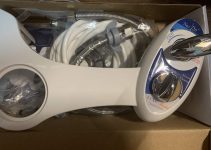Bidets use water to wash off all the waste on your butt without hurting your sensitive skin. It is a trendy personal hygiene device that can save or even eliminate the use of toilet paper. So, how much water does a bidet use? If bidets increase your water bill a lot, you may hesitate to give it a try.

Luckily, electric bidet seats only use about 0.11 gallons per session, and bidet sprayers use about 0.5 gallons per session. Considering it will cost 1.6 gallons of water for every toilet flush, the water wasted on bidets is trivial.
However, this conclusion is just a ballpark figure. The actual situation varies according to type and how you use it. You can find more information in the following sections.
How much water does a bidet use generally?
The magic of bidet lies in a splash of water, but it doesn’t use water as much as a toilet.
Previously, the toilet could cost up to 4 gallons of water per flush, but federal laws require all toilets manufactured in the United States to use no more than 1.6 gallons per flush now. In fact, many new toilets these days consume 1-gallon water per flush.
The water stream propping out from a bidet is much narrow. The average water consumption is about 0.11 to 0.5 gallons per session. Assume you or your family use it 10 times a day, and it will use 33 to 150 gallons per month.
So using a bidet doesn’t increase much on your water bill. It will cut down the majority of usage on TP and only grow a bit on the water bill, allowing you to save more money in the end.
Another thing worth mentioning is that many people using TP like to flush toilet multiple times to prevent potential cloggings. If it is the case, you can even reduce the water usage because using a bidet will not clog your toilet.
Which type of bidet uses the least water?
Electric bidet seats use the least water. These units don’t make use of the water pressure from pipes. Instead, it provides steady water pressure through its internal motor, which is lower than the pressure in the household plumbing system. These water streams are soft and narrow.
But it is doesn’t compromise when it comes to effectiveness. It has different spray modes to cater to your different needs, and many models use aerated bubble infusion technology to help propel the water to your butt.
Hence, an electric bidet seat only uses 0.08 to 0.11 gallons per session.
Bidet attachments and handheld bidet sprayers run on pure water pressure. Accordingly, they tend to have higher water pressure and flow rate.
I always advise you to start from the lowest setting to prevent any damage to your skin. Sometimes, even the lowerest pressure setting is good enough for you.
When I check the flow rate of these non-electric units, I find that the flow rate of many handheld bidets is about 2 gallons per minute. Since we don’t use the maximum water pressure and the average time of each session is about 20 to 30 seconds. The water consumption would be 0.5 gallons per session.
I don’t find any data about attachments, but it could be similar to these handheld units.
Electric bidet seats are way more expensive than non-electric bidets, but they can save more water.
How to make a bidet use less water?
The way you use the bidet will affect how much water a bidet uses. There are a few ways to use less water.
Change session time according to your condition
If you have a bidet attachment or a handheld bidet sprayer, you can control the session time as you want.
For example, you can cut down the session time when you have a clean bowel movement. Learn to trust your bidet. It could get you squeakily clean within a short time.
Find the proper water pressure
Many people hesitate to turn to an electric bidet because they have already gotten used to the high water pressure their non-electric models provide.
However, you may not need such high pressure to make yourself clean. To decrease water pressure, it may not only save more water but protect your sensitive area further.
Choose an electric bidet seat
This is the ultimate way to control water consumption. Powered by electricity, these devices have an array of ways to improve cleaning efficiency, such as changing the spray stream width or using aerated bubble infusion technology.
Conclusion
Bidet doesn’t use a lot of water. Electric bidet seats only use 0.11 gallons of water per session. Compared to the toilet’s water usage, it doesn’t show up much on your water bill.
Non-electric units could use more water because the water pressure is high without any extra help from technologies. The water consumption could be 0.5 gallons per session.
Anyway, using a bidet could not increase your water bill much, and it is a better device for the environment and your money.





